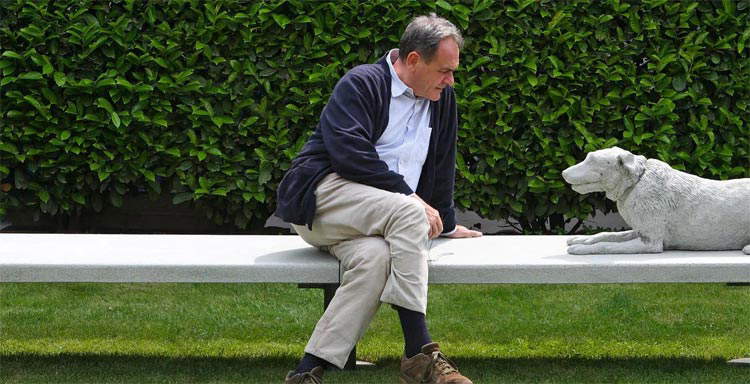Farewell to Alberto Garutti, pioneer of Italian public art
Artist Alberto Garutti, one of the most influential artists of his generation, a pioneer ofPublic Art in Italy, holder until 2013 of the chair of painting at theBrera Academy in Milan, and a professor previously also at the Academy of Fine Arts in Bologna, passed away yesterday at the age of 75.
Born in Galbiate (Lecco) in 1948, he moved to Milan in the 1950s, graduating in Architecture from the Milan Polytechnic and beginning his artistic career by collaborating with gallery owners Massimo Minini, Lucio Amelio and Paul Maenz, making his debut with a solo show in 1975 at the Diagramma gallery in Milan, arriving at great international success relatively late: in fact, his first participation at the Venice Biennale was in 1990, with a solo room at the Italian Pavilion in which he had presented works from the series Orizzonti, glass plates painted half in white and half in black, each dedicated to a client or collector (whose name he bears), imagining that the horizon line on the work binds all the steps of his career.
The first, important public art projects date back to the 1990s, for example This work is dedicated to the girls and boys who fell in love in this small theater, renovation of a theater in Peccioli where Garutti affixes a slab with the phrase that gives the work its title and represents the artist’s first public commission. Here begins the method that will characterize all his subsequent works, as explained by the artist himself: “the encounter with the citizens, the recipients of the work, but indirectly also its commissioners, understood as a pick to stimulate a linguistic updating of the work; the investigation into the territory, whose historical memory the work does not affect, but rather makes its theme; the commentary on the economic dynamics of the art system, for which the artist provides his or her ’professionalism’ and entire budget for an intervention that is ’useful’ to the citizenry; the use of the caption as an activating device and the dedication as the ’perpetual engine’ of the work.” Along the same lines is another of his most famous works, To Those Born Today (1998), an intervention by which the artist brightens the light of the street lamps of a place in a city (a street, a square or a bridge) every time a child is born, or Dedicated to the Tenants Who Live Beyond of the wall (1996-1999), sensors that are activated when a room in a building is inhabited by someone, and then Alba giorno sera notte (1998), one hundred and twenty colored light bulbs arranged in a room of Villa Borromeo in Senago to recreate the colors of the sky in the four phases of the day. Among his best-known works also worth mentioning The dog portrayed here belongs to one of the families of Trivero. This work is dedicated to them and to the people who sitting here will talk about them, from 2009, a series of benches installed in Trivero (Biella) on which dogs belonging to local families are carved.
Particularly evocative works such as Dedicated to the girls and boys who danced in this room (2000), installed at Palazzo Doria Pamphilj in Valmontone (a work that consists of a series of sensors that are activated as visitors pass by transmitting musical motifs chosen by the elderly of the Lazio town, from among those they loved in their youth), Love Stories (photographs of couples whose relationship was born at Sant’Andrea in Rome), Irrigators (2003), an intervention with the artist serving nature between the useful and the beautiful by modifying an irrigator so that the ’action on the field to be irrigated becomes a kind of dance, and then again the celebrated All the steps I have taken in my life have brought me here, now (2004 - ), a work that simply by engraving on a slab the phrase that gives it its title wants to suggest to the observer a reflection on his existence and the complexity of his life.
The first retrospective on Garutti, organized by the PAC in Milan, dates back to 2012, while the last work, created for the MAXXI in L’Aquila on behalf of the Ministry of Culture, is from 2021. His last intervention, on the other hand, was last February, when at Arte Fiera in Bologna he had repurposed an edition of one of his most famous installations, What happens in the rooms when people leave? At night, when the lights were off and the stands were deserted, a series of pieces of furniture scattered throughout the pavilions (chairs, tables, benches) were lit up with phosphorescent light: “The public’s perception of the work is thus altered,” the artist explained, “it can only be imagined, thought about, waited for. It is in this immaterial tension that the nature of the work is revealed: the work is realized only in the encounter with the viewer.” This was also the basis that animated his research.
 |
| Farewell to Alberto Garutti, pioneer of Italian public art |
Warning: the translation into English of the original Italian article was created using automatic tools. We undertake to review all articles, but we do not guarantee the total absence of inaccuracies in the translation due to the program. You can find the original by clicking on the ITA button. If you find any mistake,please contact us.



























